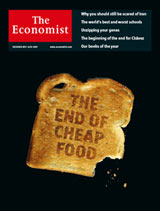 Peak Grain
Peak Grain
Feeding nine billion after Peak Oil and Climate Chaos
All societies more complex than hunter-gatherers depend on agriculture to survive. This fundamental fact is easily ignored in shopping centers of giant urban metropolises, but the advent of electronic technology, petroleum combustion and globalized economies does not reduce the need for someone, somewhere to grow the food that all of us eat.
Now that Peak Oil and climate change are no longer distant concerns but are the reality of daily events, the impact of these twin crises upon the global food supply is an urgent situation without precedent in history. Peak Oil threatens to remove key energy inputs for industrial agriculture and climate change is starting to destabilize growing conditions that make large scale food production possible.
In the United States, much of the attention focused on Peak Oil and climate change highlights personal automobile use. Most efforts marketed as solutions to these inseparable emergencies recommend surface level solutions -- changing the brand of car (buy a hybrid), maybe driving less or using public transit and bicycles. While shifting toward more efficient personal transportation would be part of any real mitigation strategy, the most important area to focus upon is global food security, since real issue of Peak Oil is food security.
In 2004, From The Wilderness (FTW) published "Eating Fossil Fuels" by Dale Allen Pfeiffer, an excellent summary of modern agriculture’s dependence upon petroleum inputs. This article is the basis for Pfeiffer’s book "Eating Fossil Fuels: Oil, Food, and the Coming Crisis in Agriculture." Another must-read introduction to our oily food system is Richard Heinberg's essay "Threats of Peak Oil to the Global Food Supply," available at www.richardheinberg.com/archive/159.html
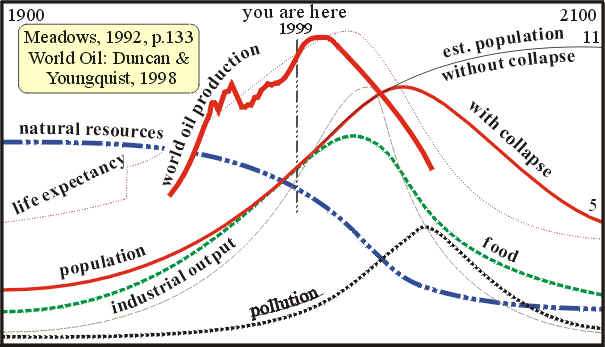
chart prepared by www.dieoff.org, a resource on petroleum, population and food
Climate Crisis and Industrial Agriculture
The timing of climate change and Peak Oil may be simultaneously synergistic and beneficial. The economic and political consequences of the end of cheap oil will make it more difficult for sane strategies to be implemented by local communities or countries (it takes energy to build solar panels or to relocalize agriculture). However, the downslope of Hubbert’s peak will result in decreasing combustion of fossil fuels (especially if the use of ultra-polluting coal can be restrained), which could mitigate the climate disaster. In other words, civilization is in trouble without the energy resources it is dependent upon, but civilization is also in trouble from the ecological consequences of burning these resources.
In the wake of Katrina and many smaller weird weather incidents, the scientific community, pop culture and even the mainstream media seem to finally accept the reality that we are changing the climate. But the new level of attention toward global warming has rarely focused on this destabilization upon food production.
Perhaps the most important skill for successful agriculture is understanding the timing of the seasons. Each ecoregion has unique attributes that enable growing certain foods, which farmers have observed for many millennia. (Even hunter-gatherers have had to understand the timing of plants and animals to ensure a steady diet.)
Climate change threatens to unravel the stability necessary for successful food growing. Some industry propagandists claim that increased carbon dioxide in the atmosphere will benefit plants, but it is unlikely any of these people are gardeners. In the temperate climates found in most of the United States, farmers plant crops after last frosts (or have fruit trees that blossom after the last frost). These adaptations are at risk from early warming in late winter or early spring, since blossoms that flower and are then frozen are not going to produce food.
Excessive heat and drought also threaten the food supply. The July 2006 heat wave that covered most of the continental United States produced record temperatures throughout most of the primary agriculture centers for the country, which will increase food costs at the same time that rising energy prices make food production and transport more expensive. This scenario is shaping up to be a "perfect storm” yet it is not part of the public debate during the 2006 election season.
www.hindustantimes.com/news/181_1915303,0005.htm
www.truthout.org/issues_06/013007EA.shtml
Millions to Go Hungry by 2080: Report
By Rob Taylor
Reuters
Tuesday 30 January 2007
Canberra - Rising temperatures will leave millions more people hungry by 2080 and cause critical water shortages in China and Australia, as well as parts of Europe and the United States, according to a new global climate report.
By the end of the century, climate change will bring water scarcity to between 1.1 and 3.2 billion people as temperatures rise by 2 to 3 Celsius (3.6 to 4.8 Fahrenheit), a leaked draft of an Intergovernmental Panel on Climate Change (IPCC) report said.
The report, due for release in April but detailed in The Age newspaper, said an additional 200 million to 600 million people across the world would face food shortages in another 70 years, while coastal flooding would hit another 7 million homes.
"The message is that every region of the earth will have exposure," Dr Graeme Pearman, who helped draft the report, told the agency on Tuesday.
"If you look at China, like Australia they will lose significant rainfall in their agricultural areas," said Pearman, the former climate director of Australia's top science body, the Commonwealth Scientific and Industrial Research Organization.
Clearcuts and climate crisis
The climate crisis is not only caused by increasing carbon levels in the atmosphere. Large scale deforestation from industrial clearcutting is altering rainfall patterns that are critical for food production. Interior continental regions get much of their rainfall "recycled” by upwind coastal vegetation, and their removal can shut off this vital moisture transport system. These types of regions include most of the world’s large grain growing areas, especially the Great Plains of North America.
Over the past several decades, most of the primary forests along the Pacific coast (Cascades, Sierra Nevada and Coast ranges) have been clearcut. The precise long term hydrologic impact of converting these old growth forests to tree farms is difficult to determine, but it is obvious that deforestation causes desertification. Continued cutting of coastal forests threatens the global grain supplies.
http://web.mit.edu/eltahir/www/eltahir2.htm
WEDNESDAY, NOVEMBER 19, 1997
Researcher wins presidential award for work on rain forests and rainfall
By Denise Brehm
News Office
An MIT scientist whose work provided evidence that deforestation of specific sections of rain forest increases the prospect of widespread regional drought was recently selected by President Clinton to receive a Presidential Early Career Award for Science and Engineering.www.oilempire.us/deepecology.html
To Wake Up One Day Different: a dialogue between Ram Dass and John Seed
To give an example of the scale of the destruction that's going on, the present Minister of Environment in Brazil, Jose Lutzenberger, was one of the great environmentalists in Brazil and was appointed Environment Minister as an answer to Brazil's critics, I suppose. So he quoted some studies a year or two ago of the amount of solar energy that was captured by the jungle in the Amazon necessary to lift the amount of water up into the atmosphere that was taking place there. We have in the Amazon this huge river, but the hydrological cycle in the Amazon is five times as much water as the Amazon River itself. It was calculated that the amount of energy required was the equivalent of two thousand hydrogen bombs a day of solar energy that was captured by the vegetation to lift this water into the air. So this is a huge heat engine that drives the winds of the world, those winds that the ancient mariners knew and the same winds that deliver moisture regularly and predictably to this country and to Europe. They don't just exist, they're not "just there" the way that we think, but they're actually continuously being created and maintained by the large biological systems. This is one of the vital organs of Gaia, the living planet. Lutzenberger says that if we lose as little as one third of the Amazon, it will irreversibly disrupt this process.
First of all the rest of the Amazon will start dying back because the immediate hydrological regime will have been disrupted, and then of course the climate everywhere around the world will be disrupted. So what this says is that to save a huge national park here and a huge national park there - even if we could do it, which we're not even successful in doing because the national parks are being colonized and burnt before our eyes, but even if we could do that - it's not enough. It's based upon a false metaphor of what life is and what the Earth is.
Peak Grain
The annual increase in world grain production is slower than the rate
of population increase, and seems to be nearing an all time "peak”
of production. There are few places left on the planet where additional
crop land could be developed, and continued production increases after
Peak Oil and climate change seem unlikely.
The Earth Policy Institute in Washington, DC has excellent reports about
peaking world food supplies:
www.earth-policy.org/Indicators/Grain/2006.htm
June 15, 2006
WORLD GRAIN STOCKS FALL TO 57 DAYS OF CONSUMPTION:
Grain Prices Starting to Rise
www.earth-policy.org/Indicators/Grain/2006_data.htm
World Grain Production Per Person, 1950-2006
the "per capita” peak occurred in the early 1980s, just as the per capita peak of petroleum production was around 1979.
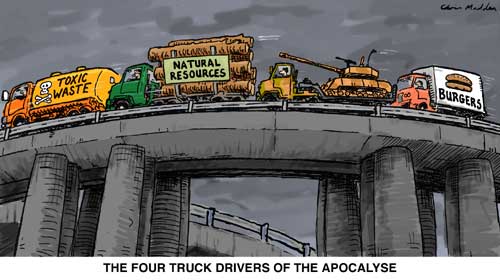
Many Peaks
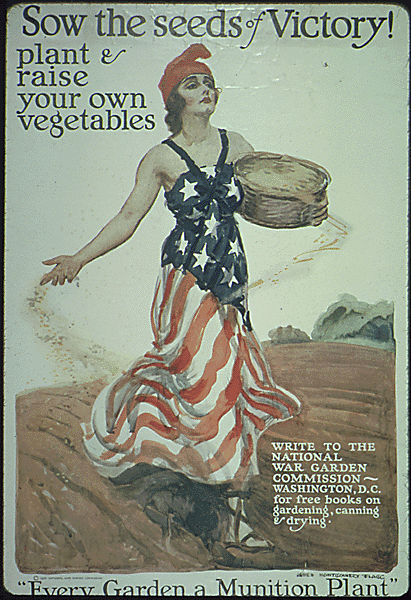 Peak Oil is not the only resource constraint facing civilization. Other
non-renewable resources such as natural gas and mineral
ores are also past peak - the "low hanging fruit" of the
most easily extracted gas deposits and ores are gone.
Peak Oil is not the only resource constraint facing civilization. Other
non-renewable resources such as natural gas and mineral
ores are also past peak - the "low hanging fruit" of the
most easily extracted gas deposits and ores are gone.
A more complicated issue is the peak of renewable resources that replenish themselves on a faster time scale but are currently overused. Most of the world's ocean fisheries are in collapse due to overharvesting. Only a few percent of North America's native forests are still standing. Aquifers are being drained to irrigate agriculture in the Great Plains (largely for beef production). These land abuses are causing deserts to expand, which creates a feedback loop (more deserts results in less rain which further expands deserts).
Many commentators have noted that perhaps three Earths would be required to support the current human population if everyone lived the overconsumptive North American lifestyle. However, the current, single Earth that we all share is groaning under the stress of supporting the "American Way of Life" (AWOL), which Vice President Dick Cheney says is not negotiable.
Civilization's choice: two scenarios
The most important question facing the human race is how we respond to the interconnected crises of Peak Oil, climate change, overpopulation, the fading of democratic institutions, and resource conflicts.
How we use the remaining oil determines the future of the human race:
- do we "spend” it on solar panels or battleships?
- on relocalizing food production or further "globalization” of production?
The Permanent State of Emergency
Journalist Ross Gelbspan in his book "The Heat is On: the Climate Crisis, the Cover-up, the Prescription" calls climate change the "permanent state of emergency.” He states that the impacts of overpopulation, peak food, climate change and other limits to growth threaten to combine into a severe test of the ability of civilization to continue. Gelbspan’s website www.heatisonline.org is one of the best sources for understanding these issues.
The outcome of this deterioration is loaded with totalitarian potential. In the mid-1980s, a thirty-year growth in global food supplies reached its peak. Food production is now declining. Today only two of the world's 183 nations -- the United States and Canada -- are major exporters of grain. Yet as the world's population expands at an almost exponential rate, the earth is losing nearly 1 percent of its agricultural lands every year.
Nor is the situation with available water much better. In many arid parts of the world, freshwater resources are becoming overtaxed. They are depleted by industrial overuse and by the demands of growing concentrations of people in the cities of the developing world. United Nations secretary-general Boutros Boutros-Ghali was deadly serious when he noted, a few years ago, that the next war in the Middle East will be fought not over oil but over water.
-- Ross Gelbspan, "The Heat is On"
In 2003, futurists Peter Schwartz and Doug Randall wrote a report for the US military titled "An Abrupt Climate Change Scenario and Its Implications for United States National Security." This unclassified study predicted that global warming’s impacts on food supplies, water availability and other changes would exacerbate global conflicts.
From the Wilderness published several articles in 2005 and 2006 documenting the US military’s interest in acquiring renewable energy systems to power its bases - the Schwartz / Randall report shows that the military command is also paying close attention to climate change (some of the best documentation comes from military satellites and other monitoring systems). This report is archived many places, including at www.permatopia.com/documents.html
Many environmentalists complain that George W. Bush and Dick Cheney don't know about climate change, and therefore continue to ignore these problems. But reports such as Schwartz / Randall suggest that the administration is in fact well aware of the situation -- but merely is not going to address the crisis since the ethical solutions decentralize political and economic power.
George W. Bush's "ranch" in Crawford, Texas has 25,000 gallons of rainwater catchment, ostensibly for watering plants. While rainwater harvesting is not a radical concept in many parts of the world, this installation suggests that Bush really does know that the climate is shifting. Regardless of motivation or understanding, his water tanks ensure that his guards will be able to drink water in the post-Peak Oil, post-climate collapse world.
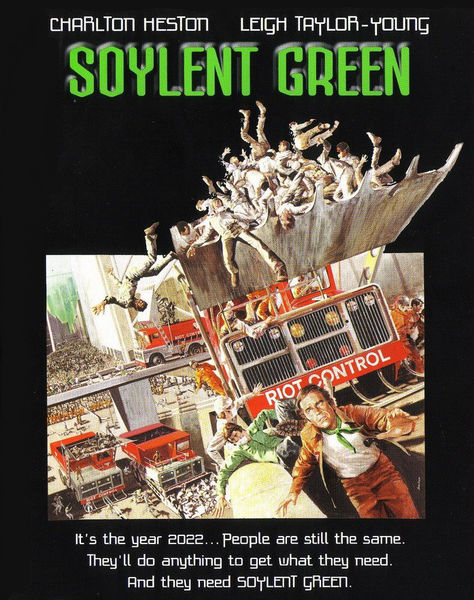 The Project for a New American Century's September
2000 report "Rebuilding America’s Defenses” is most famous
for its prediction that a "new Pearl Harbor” was needed to
enable the neo-conservative global domination plans. But an even more
outrageous assertion in the report was that
The Project for a New American Century's September
2000 report "Rebuilding America’s Defenses” is most famous
for its prediction that a "new Pearl Harbor” was needed to
enable the neo-conservative global domination plans. But an even more
outrageous assertion in the report was that
... advanced forms of biological warfare that can "target" specific genotypes may transform biological warfare from the realm of terror to a politically useful tool."
- Rebuilding America’s Defenses, September 2000, Project for a New American Century www.newamericancentury.org
In 2003, FTW published Unholy Grail: The Quest for Genetic Weapons by Kellia Ramares that documented efforts to develop these sorts of ethnically specific weapons. Is this high-tech genocide the endgame for the global resource war masquerading as the fight against terrorism? While it is true that a sudden reduction of world population would make the resources last longer, the consequences of such an evil act are impossible to predict. It is likely that these vicious technologies are not the exclusive domain of any country or faction - so a "mutual assured destruction” situation is probably already, quietly, in place. Furthermore, this scenario assumes assumes an ability of government and corporate powers to keep the distribution networks intact, at least for those who are still considered worthy of receiving these goods. A full examination of the nasty possibilities of this scenario are beyond the scope of this article, but most people who've thought about these issues have their own nightmares about what could happen.
The film Soylent Green depicted an overpopulated world where food supplies are scarce due to ecological collapse.
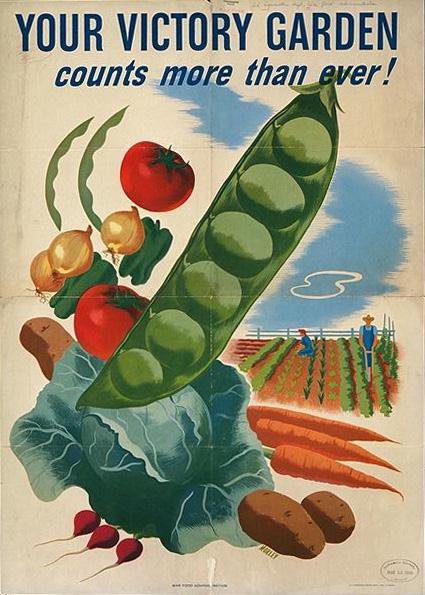 The Solution is LOV: Local, Organic, Vegan
The Solution is LOV: Local, Organic, Vegan
We have the technical means to feed, clothe, and house all humanity. But legions starve because we have not learned to tolerate and support one another. People’s real problems are not technical, they are social and political.
- Toby Hemenway
http://energybulletin.net/3757.html
World population was under one billion people before the age of oil, coal and natural gas, and figuring out how to have a graceful population peak with a gentle downslope is the most critical task facing humanity. If the money, material resources and human skills currently invested in the military-industrial complex were shifted toward a “permaculture for nine billion” scenario, it is possible that the myriad impacts of Peak Oil and climate change could be adequately mitigated.
Think Globally, Eat Locally
Community food security efforts in the United States have expanded farmers markets, Community Supported Agriculture (CSA) farms, community gardens and emphasized the need to eat local food less dependent on long distance shipping. However, few efforts to relocalize food or teach gardening skills include grain production -- this is perhaps the most challenging part of the food puzzle.
Many suburban lawns and golf courses have great opportunities a Food Not Lawns conversion to grow grain crops instead of decorative grasses. Wheat, barley, corn, quinoa, amaranth and other grains are great additions to gardens and farms. Nut trees that are appropriate to local climates can out produce grains per square foot (after they become mature).
 If climate change alters growing seasons, the talents of plant breeders
will be needed to select plant varieties adapted to the new conditions.
These skills have been perfected over thousands of years yet are rarely
taught in our modern schools of agriculture. Our dominant agribusiness
systems seek uniform production despite local conditions, a strategy that
lacks the resilience needed to cope with climatic variation. Local food
security must include locally adapted varieties of crops.
If climate change alters growing seasons, the talents of plant breeders
will be needed to select plant varieties adapted to the new conditions.
These skills have been perfected over thousands of years yet are rarely
taught in our modern schools of agriculture. Our dominant agribusiness
systems seek uniform production despite local conditions, a strategy that
lacks the resilience needed to cope with climatic variation. Local food
security must include locally adapted varieties of crops.
Organic is not the same as Sustainable
Organic food avoids some of the problems with toxic, petroleum based inputs (pesticides), but it is still dependent on fossil energy to run tractors, transportation and food processing. While organic food is preferable to so-called conventional food, organic certification is not “sustainability.”
In recent years, most of the largest companies in the organic food movement in the United States have been bought out by transnational corporations. An excellent chart of this consolidation is Corporations Buying and Owning Organic Food Companies. This development is a recognition of the growth of this food sector as more people realize that it is not healthy to eat petroleum-based pesticides. It is also symptomatic of the efforts by polluting industries to water down organic standards to ensure that their products can benefit from the label without having to change their behaviors.
The more local a food supplier is, the easier it is for the eaters to know how food is growth or processed -- and the best producers use techniques that go far beyond merely “organic.”
Organic Consumers Association is a national citizens group dedicated to protecting organic food standards and stopping toxic technologies.
Vegetarian Diets: Energy Efficient Eating
The fastest way that agribusiness could reduce oil consumption would be to decrease factory farm production of meat. This shift would probably be more controversial than relocalization or organic standards.
Adopting a largely plant based diet in the rich parts of the world is not an issue of animal rights or nutrition - but it is needed survival in the era of Peak Oil and climate change.
Humans did evolve to be omnivorous, but the fast food diet of meat at every meal is a new, toxic innovation. The traditional Chinese style diet of a small amount of meat to flavor the rest of the meal is probably compatible with our vegetarian oriented digestive tract, but our factory farmed meat-three-times-a-day diet is unsustainable under any circumstances.
Most estimates of the amount of fossil energy and other inputs needed to produce food assume a meat oriented diet, ignoring the fact that much less oil, fertilizer and water is needed to feed vegetarians. Even rice requires much less water than hamburgers!
Raising chickens on a small farm or suburban backyard for eggs (and the occasional meal of meat) is not as energy consumptive as overcrowded factory farms, but these sensible practices are unlikely to satisfy current rates of meat consumption. Grass fed beef is healthier for the land and the eater than grain fed beef, but shares the density problem -- free range cows are not going to be able to substitute completely for feed lots.
“in a former life, one of the things I did was to be a farmer. I would caution that we need to be careful how optimistic we are about how much liquid fuels we're going to get from agriculture ... a fifth of the world will go to bed hungry ...
If we lived lower on the food chain we would have some energy to invest [in biofuels] ...
if you were to eat the corn and soybeans rather than the pig and chicken that ate the corn and soybeans, you would have about 10 times more to eat ...
it takes three pounds of corn to produce one pound of pig but that's three pounds of largely dry corn to produce one pound of really wet pig... you don't eat the bones so the actual conversion ratio if you're lucky is ten to one, for the steer it's probably twenty to one”
- Rep. Roscoe Bartlett, May 8, 2006 at the "Peak Oil and the Environment" conference in Washington, DC www.oilempire.us/audio.html has the archived recording (panel discussion with Roger Bedzek, Kenneth Deffeyes and Michael Klare)
"Nothing will benefit human health and increase chances for survival of life on earth as much as the evolution to a vegetarian diet."
-- Albert Einstein"I don't understand why asking people to eat a well-balanced vegetarian diet is considered drastic, while it is medically conservative to cut people open and put them on powerful cholesterol-lowering drugs for the rest of their lives."
-- Dr. Dean Ornish, author, Reversing Heart Disease"American feed (for livestock) takes so much energy to grow that it might as well be a petroleum byproduct."
-- Worldwatch Institute) ("The Price of Beef," WorldWatch, July/Aug 1994, pg 39)“It is actually quite astounding how much energy is wasted by the standard American diet-style. Even driving many gas-guzzling luxury cars can conserve energy over walking -- that is, when the calories you burn come from the standard American diet!”
-- John Robbins, “Diet for a New America” Stillpoint Publishing (1987)www.veg.ca/issues/enintro.html
Meat production's environmental toll
Wilderness destruction, soil erosion, energy waste, and pollutionwww.madcowboy.com/01_FactsENV.000.html
Mad Cowboy Howard Lyman’s website discusses environmental problems of meat production.www.earthsave.org/environment/foodchoices.htm
How Our Food Choices can Help Save the Environment
by Steve Boyan, PhD
The modern factory farming system is a prolific consumer of fossil fuel and a prolific producer of poisonous wastes. Up to 100,000 animals are herded together on huge feedlots. These animals do not graze on grass, as picture books tell us; they can’t graze at all. Feedlots are crowded, filthy, stinking places with open sewers, unpaved roads and choking air. The animals would not survive at all but for the fact that they are fed huge amounts of antibiotics. It is now conceded that the antibiotics fed to cattle are the main cause of antibiotic resistance in people, as the bacteria constantly in these environments evolve to survive them. The cattle are fed prodigious quantities of corn. At a feedlot of a mere 37,000 cows, 25 tons of corn are dumped every hour. It takes 1.2 gallons of oil to make the fertilizer used for each bushel of that corn. Before a cow is slaughtered, she will eat 25 pounds of corn a day; by the time she is slaughtered she will weigh more than 1,200 pounds. In her lifetime she will have consumed, in effect, 284 gallons of oil. Today’s factory-raised cow is not a solar-powered ruminant but another fossil fuel machine.
Part of the deforestation of the Amazon rainforest is due to large soybean plantations that are growing on former forest lands. But these soybeans are not going to feed vegetarians seeking meat-free alternatives - most of the world soybean crop goes to farm animals, not to feed people.
Billboard in Minot, North Dakota, next to the Amtrak station, May, 2006.
(The missile fields around Minot have more weapons of mass destruction
than the combined nuclear arsenals of Israel, Pakistan and India.)
www.sciencedaily.com/releases/1997/08/970812003512.htm
Posted: August 12, 1997
U.S. Could Feed 800 Million People With Grain That Livestock Eat, Cornell Ecologist Advises Animal Scientists
MONTREAL -- From one ecologist's perspective, the American system of farming grain-fed livestock consumes resources far out of proportion to the yield, accelerates soil erosion, affects world food supply and will be changing in the future.
"If all the grain currently fed to livestock in the United States were consumed directly by people, the number of people who could be fed would be nearly 800 million," David Pimentel, professor of ecology in Cornell University's College of Agriculture and Life Sciences, reported at the July 24-26 meeting of the Canadian Society of Animal Science in Montreal.
CORN, COWS, CARS AND COLLAPSE
The great corn fields of the American midwest are not for corn on the cob -- these monocultures primarily feed cows. These corn varieties are not very digestible for humans (and aren’t good for cattle who evolved to eat grasses).
Rising demand for “biofuel” derived from industrial corn is colliding against existing uses. The choice that many observers have predicted - between food for people and burning food for cars - is really a choice of “meat versus biofuels.”
The best choice for civilization is clear -- we need what Pat Murphy of Community Solution calls “Plan C” -- The Conserver Option : Curtailment, Cooperation, Community. Efficiency by itself will not be enough to solve the enormous challenges we all face, but it could buy us a little time for deeper shifts.
As global granaries pass "Peak Grain" the world must decide if the American diet is more important than addressing preventable world hunger. We will only be able to feed the expected nine billion people if we abandon factory farming as a basis for agriculture. Energy efficient diets are a critical part of any plans for a global powerdown scenario to bridge the gap of energy decline. Efficiency in food, transportation and other consumption patterns are prerequisite for a best case scenario of a gradual, long, gentle, peaceful population decrease. Permaculture and renewable energy and other approaches could probably increase our ability to support more people than lived in 1800 after the oil is gone.
For additional reading:
www.i-sis.org.uk/FTWUCC.php
Published on 21 Jan 2005 by Institute of Science in Society.
Feeding the World under Climate Change
by Edward Goldsmith / ISIS
www.i-sis.org.uk/DreamFarm.php
Dream Farms
Abundantly productive farms with zero input and zero emission powered
by waste-gobbling bugs and human ingenuity - Sustainable development is
possible
Dr. Mae-Wan Ho
Forget oil, look at food prices
By Tumi Makgetla
Johannesburg, South Africa
22 October 2006 06:00
www.mg.co.za/articlePage.aspx?
articleid=287325&area=/insight/insight__economy__business/
www.thestandard.com.hk/news_detail.asp?we_cat=9&art_id=20210&sid=8272820&con_type=1&d_str=20060607
Grain crisis looms in Japan
Most Japanese think food shortages are a problem that only afflicts impoverished
countries, and they've been right - until now.
Aya Takada
Wednesday, June 07, 2006
A Combination of Triple Scourges This Winter Along with Peak Oil, Peak
Grain and Peak Water the world enters crisis overload
by Mathew Maavak
Korea Herald
www.koreaherald.co.kr/SITE/data/html_dir/2006/08/01/200608010023.asp
Global Warming Could Slam Food Supply
Food Prices Could Rise as Farmers in California's Prolific San Joaquin
Valley Feel the Effects
By Bill Blakemore and Clayton Sandell
Fresno, California
Saturday, Aug. 5, 2006
http://abcnews.go.com/WNT/GlobalWarming/story?id=2277893&page=1
The Post-Petroleum Survival Guide and Cookbook by Albert K. Bates
The Humanure Handbook: A Guide to Composting Human Manure by Joseph Jenkins - the definitive guide to recycling nitrogen back into the soil. As the natural gas feedstocks used to make synthetic fertilizers are depleted, humanure will be the solution for maintaining soil fertility. (Sewage sludge from municipal sewage systems is not humanure - it is not composted and it usually contains unacceptable toxins flushed down drains that render it hazardous for farm fields.)
Mycelium Running: How Mushrooms Can Help Save The World,” by Paul Stamets www.fungi.com
Starhawk has written several articles about bioremediation in New Orleans after Katrina that are important pieces of the puzzle for reversing pollution and shifting toward sustainability - www.starhawk.org




